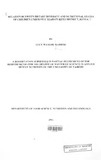Relation between dietary diversity and nutritional status of children under five years in Kitui district, Kenya
Abstract
Dietary diversity has long been recognized by nutritionists as a key measure of the
diet quality because nutrients essential for meeting nutritional requirements are not
always found in sufficient amounts in a single food item. Increasing the variety of
foods across and within food groups therefore increases the chances of adequate
intake of nutrients by an individual. Children under the age of 5 years are among the
most vulnerable to malnutrition and their diversity though may be different from that
of adults, is still important in determining their nutrient intakes. Children also respond
more readily to changes in food availability than adults. This study was designed to
assess the association of dietary diversity with the nutritional status of children under
five years of age.
A cross sectional study was carried out in March 2010 in Kitui district of Kenya on a
sample of283 non -breast feeding children with their mothers/caretakers as
respondents. Information was collected using a 24-hr individual dietary diversity
questionnaire comprising of 14 food groups to determine the food group consumed.
Dietary diversity scores were calculated to measure diet diversification.
Anthropometric measurements of the weight and height of the children were taken
and the age and sex of each child recorded. Results were analyzed using excel, JMP
statistical discovery and ENA for SMART software's. Descriptive statistics,
correlations and analysis of variance were performed with P<0.05 being considered as
the statistically significant level of difference.
Results revealed that the children consumed 2 to 8 of the 14 food groups used in the
evaluation, with a mean of 5 food groups. There was indication of low consumption of animal products including milk, meat and eggs and high consumption of plant
products. Stunting was at 47.3%, underweight at 29.8% and wasting at 4.6%. It was
shown that there was a highly significant positive correlation between total income
received by the household and Individual Dietary Diversity Scores (IDDS). There was
also a positive correlation between IDDS and nutritional indicators of stunting,
wasting, underweight and MUAC. Nutritional status was found to improve with an
increase in dietary diversity. Although consumption of animal product was low, the
number of food groups consumed increased when money available to the household
increased.
Sponsorhip
University of NairobiPublisher
Department of Food Science, Nutrition & Technology, University of Nairobi

